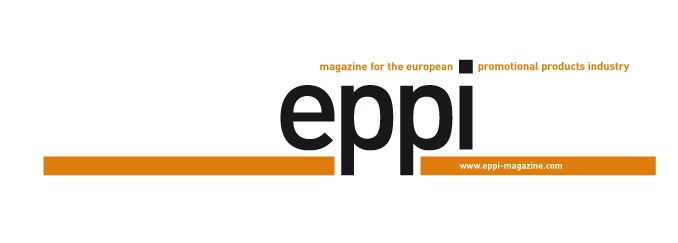Advertising bans on tobacco, drinks and food, “transparency codes” in the pharmaceutical sector, compliance delirium in the political and business world: The promotional products industry is getting into trouble with the law – frequently without justification. A ramble through the (ban) signs jungle.
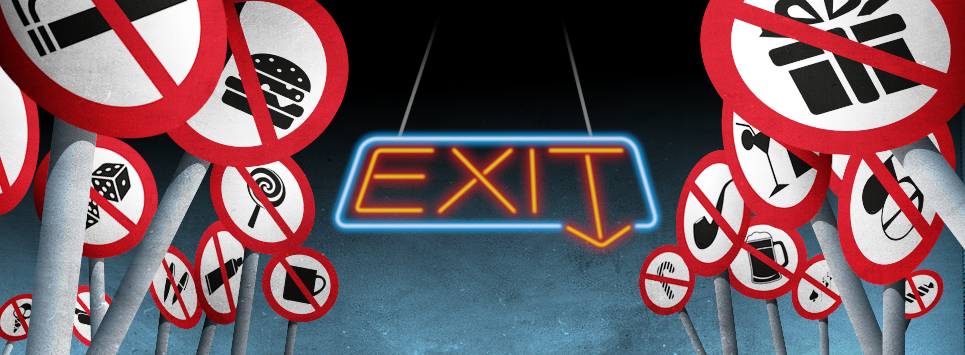
Anyone, who looks at old advertisements or TV spots, often doesn’t believe his own eyes: From today’s point of view the campaigns that are totally blunt and in line with the sledgehammer principle shout out “Buy me”, are thoroughly primitive – not to mention the questionable and often openly sexist role clichés that were used in them. Also, many things that were advertised without restrictions back then are incredulous from today’s viewpoint – for instance cigarettes: Advertising nicotine was treated in the same carefree manner that people smoked in homes, public buildings, vehicles or restaurants.
The death of the Marlboro man
This has since radically changed – tobacco products were one of the first goods for which massive advertising restrictions were imposed. The fact that Darrell Winfield, the most famous Marlboro man and only person to play the role of the advertising figure who really was a cowboy, died at the beginning of 2015, is almost symbolic for the paradigm shift that tobacco advertising has gone through. Not only would a figure such as the Marlboro man, who actively made smoking appear exemplary no longer be permitted today – the spectrum of the media that are allowed to be used to advertise tobacco products is nowadays strongly restricted, if not actually reduced to zero.
The EU tobacco guideline that came into effect in 2016, is implemented at varying degrees within the countries. In some cases the restrictions go far beyond the level demanded by the EU, such as in Great Britain for instance which is as yet still a member country: Since May 2017 all cigarettes have to be sold in a standardised green packet.
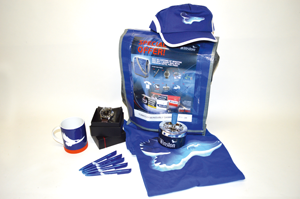
For the tobacco brand Winston, Van Bavel Enjoy Giving develops goody bags for sailors.
“Tobacco was a huge market for us in the early days, in the meantime this has come to a complete standstill – which I believe is a really good thing,” stated Gill Thorpe, CEO of the British promotional products agency, The Sourcing Team. Gordon Glenister, Director General of the British association BPMA (British Promotional Merchandise Association), added: “Although interestingly enough there are distributor websites that still sell lighters and ashtrays, no form of tobacco advertising is permitted in the UK, smoking is banned almost everywhere, there has been a boom in patio heaters. When you go to a retailer you can’t see the range of cigarettes, they are all hidden from view. There are no adverts anywhere for smoking and it has affected sports sponsorship too.” France has a similarly strict approach regarding the theme tobacco, where the uniform packets were already introduced in 2016 and every form of tobacco advertising and promotion is banned. In other EU countries there are still at least certain relaxations in the regulations. In Sweden the country-specific snuff, Snus, that is pushed under the lip and which is sold loose or in small bags, plays a special role – Snus is considered to be a trend drug on the professional sports scene European-wide. In Norway tobacco-related Internet and POS advertising as well as promotional products are still permitted in some cases, Italy allows promotions, sponsoring campaigns and displays at the POS with certain restrictions. From Belgium, Michel Van Bavel, CEO of the promotional products agency Van Bavel Enjoy Giving reported: “In Belgium hardly any advertising is allowed for tobacco anymore, it is thus very difficult for our customers from the tobacco industry to launch campaigns at all. The legislation is relatively liberal in nearby Luxemburg, which we supply with blank give-aways that are implemented in the scope of promotions, as well as in areas where duty-free goods can be sold, i.e. at ports and airports.” A promotion that Van Bavel has been running for the cigarette brand Winston since 2015 targets sailors: “Many sailors travel for weeks on end without a stopover. On buying a certain amount of cigarettes they receive a well-filled goodie bag containing numerous useful things for life on board, such as shirts, caps, sunglasses, card games or ashtrays. The campaign ran in Antwerp and other European ports, e.g. in Spain, the Netherlands and Great Britain and even to an extent in the Far East. Depending on the national law, the give-aways are allowed to be customised. The contents of the goodie bags varied from region to region too. Overall, the campaign was very successful and one of the few opportunities that allow tobacco products to be advertised.”
It is still a golden age in Germany compared to most parts of Europe, as far as tobacco advertising is concerned: An advertising ban on TV and radio spots was introduced for tobacco products a long time ago already and since 2007 the ban also applies for newspapers, magazines and the Internet. However, Germany is the only country in the EU that still allows billboard advertising for tobacco. Furthermore, POS advertising as well as sponsoring, promotion and direct marketing is also allowed for tobacco products – albeit the latter via restricted access Internet sites, prize draws and at events. Persuasive efforts that frequently and gladly involve haptic advertising. “Haptic advertising has the special advantage that it offers a long-lasting brand experience. Promotional products are an important part of our marketing activities particularly in the FMCG sector. We implement them both directly in our communications with the consumers as well as in collaboration with our trading partners,” reported Heike Maria Lau, Director Politics & Communications at JT International Germany.
In this way, high-quality premiums are implemented in the scope of direct marketing measures and many manufacturers place their bets on give-aways and onpacks at the POS to increase sales. The industry is also still investing highly in live communications. Advertising measures are no longer carried out during sports occasions or cross-border events that children and youths are present at, but instead all the more at music events. There is hardly a big music festival where a tobacco company is not among the sponsors, trying to emotionalise their brand as effectively as possible at the event. An important ingredient: haptic advertising. However, even where advertising tobacco is still allowed to a limited extent, the ground is very unstable because further bans are being intensely debated. If it were down to the WHO, advertising tobacco is to be completely banned worldwide by 2025.
For the benefit of health
The tobacco industry is by far not the only industry confronted with legislative interventions. The advertising and sales promotion of alcoholic drinks is also a much discussed theme. The EU Health Commissioner, Vytenis Andriukaitis, explicitly spoke out in favour of restricting the advertising and marketing measures for alcoholic beverages in September 2016. This demand has not yet been implemented EU-wide, however in many places regulations regarding the marketing of alcohol have already been put into place. Furthermore, a binding traffic light system which makes the labelling of the fat, sugar and salt contents of food immediately recognisable has been discussed in the EU for years. In the absence of an EU-wide regulation, France and Great Britain introduced colour-based labelling models as a voluntary self-obligation. If the EU traffic light system asserts itself at some point in time, it will of course also apply for culinary promotional products. The same is true for a sugar taxation that has already become reality in some European countries, for instance in France or most recently in Great Britain: Since April 6, beverage manufacturers have to pay a tax if their drinks contain more than 5 g of sugar per 100 ml. In many other European countries a sugar tax is being discussed.
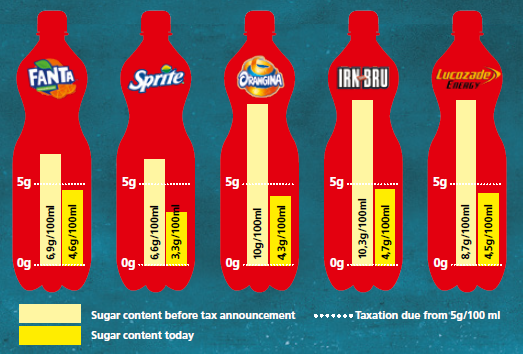
The British sugar taxation that has been in practice since April 6, 2018 proved to be effective: After the announcement of the taxation, many beverage manufacturers reduced the sugar content of their beverages significantly. (source: Foodwatch)
Extensive regulations already exist regarding so-called health claims, i.e. statements about the health-promoting characteristics of foodstuffs that the consumer often encounters in the drinks or refrigerated shelves, in the case of cereals and even often for sweets, and which are also customary in the promotional products industry. A database with health claims, which currently consists of entries for 2,320 foodstuffs, substances or food supplements that differentiates precisely which descriptions with which wording and in which connotation are allowed, is found on the website of the European Commission. But this doesn’t clarify all questions by a long way: In June 2017, for example the European Court of Justice prohibited the brand Dextro Energy that is popular on the promotional products market from printing health-related statements on its dextrose tablets.
Empowered consumers
These bans aim to protect consumer groups and prevent risks – however many advertisers feel that the intervention of the lawmakers often goes too far. “For us it is quite clear that a legal product ought to be able to be advertised in Germany,” commented Lau. “An advertising ban on the other hand more or less disables an essential competitive element and would mean the end of the last remaining big-scale advertising channel for the tobacco sector. Inevitably this would lead to the market shares freezing and in turn to market isolation. It would therefore become impossible for new and innovative products to establish themselves on the market.”
Frank Dangmann, Chairman of the German Promotional Products Association, GWW, pointed out the problems of the legal taxation of marketing activities: “The GWW represents the position that advertising restrictions constitute interference of the market, in which advertising and commercial communications are an indispensable motor for competition. Those who impose advertising bans not only inhibit the economic development, but also strip the consumers of their own rights of decision. We work in close collaboration with the ZAW (German Advertising Association), which is carrying out intensive research and education on the negative effects of advertising restrictions.” For example, a corresponding positioning is stated on the website of the ZAW: “Advertising restrictions reduce the growth of the GDP. They cut back the wealth within the population disproportionately. They make it harder for companies to gain access to the market and curb the market success of innovations.” Many national advertising associations in other European countries as well as the European Advertising Standards Alliance (EASA) have drawn up extensive position papers and dossiers on the topic.
Responsibility instead of bans
Instead of state interventions the advertising and industry associations as well as the individual companies are in favour of self-regulation and voluntary self-monitoring and make reference to their own responsibility. “Basically our advertising exclusively targets adult smokers – with the aim of winning over consumers of other brands,” stated Lau. “Of course, we act within the scope of the legal provisions and as a sector of industry have additionally agreed to a joint advertising codex. This includes among others not advertising our products near to schools, educational institutes or sports grounds.” Similar codes of conduct exist among others within the alcohol, food or gambling industries that also have an impact on all advertising measures including haptic advertising. Van Bavel cited an example from the beverage industry: “Promotions are not allowed to encourage people to drink a lot, drinking games are forbidden. Whereby campaigns where everybody at the table has to have a drink in order to enjoy a giveaway are permitted.” The self-commitment of the advertising industry also includes protecting children as an especially sensitive target group from negative influences, as Van Bavel explained further: “It is not permitted to influence children under the age of twelve. For the brand Milk Company for instance we implement toys as onpacks, but they have to be toys that twelve or thirteen-year-olds play with.”
Even though companies from the luxury goods and food industry are constantly criticised for their marketing measures, haptic advertising is accepted by and more popular with the consumers than other advertising media: According to the statistics of the European Advertising Standards Alliance only a very small amount of the number of complaints that were received in 2016 applied to below-the-line advertising measures.
The pharma hammer
Unfortunately, in the B2B sector the image of haptic advertising is frequently seen quite differently: Here promotional products are often viewed as being briberies so that compliance regulations and promotional products bans in the B2B corporate communications present a much greater risk compared to the restrictions of advertising measures targeting the end consumers. The ban on promotional products in the pharmaceutical industry that became reality about four years ago is no doubt still a painful memory for many promotional products players. “It resulted in significant turnover losses for the industry,” stated Dangmann. “The GWW already filed a complaint with the Federal Cartel Office and with the European Commission in July 2013 – in other words a year before the transparency code came into effect – and pointed out to the pharmaceutical industry that the codex would mean they were robbing themselves of one of their most important forms of advertising – unfortunately their efforts proved unsuccessful.” “Millions were lost when pharma companies were no longer able to give away promotional products to a healthcare professional,” stated Glenister. “The only caveat was for conferences and events where it was used for educational purposes so there are still pens and notepads being driven through the sector.”
Since the transparency codex, alongside items that have an informative character and a clear association to the product which furthermore don’t surpass a given value, exclusively promotional products for consumers and for medicines that are available without prescription – so-called OTC drugs – are permitted. However, this regulation is standing on rather unstable footing: Just recently in February 2018 for instance the Higher Regional Court of Stuttgart prohibited a pharmaceutical manufacturer from implementing a product case containing medicines against colds, which he had given a chemist because awarding the chemist case free of charge would implement “the abstract risk of taking a non-objective influence”. The verdict went on to explain that this could lead to the chemist in question recommending the products of the manufacturer to his customers.
In the compliance trap
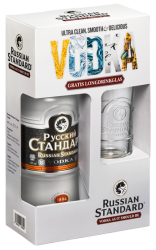
On-pack promotions featuring promotional products are an indispensable marketing tool for the drinks industry.
Such cases may contribute towards increasing the fears of the end users within the companies – because compliance and “bans on gifts” have long since not only been a topic in the pharmaceutical industry, but within virtually all big companies meanwhile. “The big multinationals mostly have a policy that strictly regulates the implementation of promotional products and they predominantly use low-priced products that are more considered to be marketing materials in order to avoid being accused of bribery,” said Andre Noordwijk, CEO of the Dutch promotional products agency, Be- Global Promotions. “Banks and finance service providers are also very sensitive in this respect. At the end of the year many companies are generally not allowing individuals to receive gifts – the Christmas hampers called Kerstpakketen, which are widely-distributed in the Netherlands, are an exception to the rule here, because they are sent to employees by the management.” Van Bavel confirmed: “In Belgium the value threshold for the tax deductibility of promotional products is 50 Euros per recipient per year. However, many companies only implement products that are worth much less so that they are not accused of trying to influence people. Due to compliance reasons in many companies it is customary that end-of-year gifts are not allowed to be accepted, but instead collected and raffled off among the employees.”
This is particularly annoying if one’s own compliance regulations are only implemented selectively: That the pharmaceutical industry has to a large extent banned promotional products, but nevertheless still attracts groups of customers with incentives is a known fact in the same way that many other companies try to give away gifts as customer relations measures. Van Bavel: “Our biggest rivals in the year-end business have become providers like Zalando and Amazon – because many companies now are tending to implement voucher codes for online shops that they can send their customers discretely without the compliance department getting wind of it.”
However, especially since many companies tend to be inconsistent in their compliance policies there are still possibilities for promoting companies to escape the “tombola” in a simple and harmless way: “We advise our customers for instance not to implement corporate gifts at the end of the year when companies are particularly vigilant regarding compliance and all of the gifts end up in the tombola, but instead between January 15 and December 10,” said Van Bavel. “Why not present a token of appreciation at Easter or a travel accessory at the beginning of the holiday season at the end of June? The compliance rules are not adhered to as strictly at these times of the year and the probability that the customer or contact partner takes the gift intended for him home is much higher. Furthermore, products that don’t have a strong gift character, which are more like communication media instead, are not as likely to be perceived as ‘corruption attempts’.”
Explanatory work
The discussion about the admissibility or non-admissibility of smaller gifts is actually superfluous in many cases, as Dangmann explained: “Indeed promotional products shouldn’t even be judged according to compliance rules. It is explicitly stated in the ‘Codex on the delimitation of legal customer care and corruption’ of the Corporate Compliance Working Committee that promotional products and give-aways up to a value of 50 Euros are considered to be ‘smaller tokens of appreciation’ and that they are unproblematic when implemented occasionally. This applies for all industries except for the health sector. This clear statement is unfortunately not common knowledge – or the recommendations of the compliance bodies are exceeded due to anticipatory obedience. We are trying to interject here and explain the situation.” An important tool here is the “Compliance Guideline” that the GWW recently published. It targets promotional products consultants and sales force members and provides arguments that can be used to react to the compliance objections of customers. At the same time, the guideline targets marketing, advertising and sales departments that would like to implement promotional products, but who are less and less allowed to do so.
The GWW itself puts its arguments forward to the responsible people in business and political circles in the form of extensive networking and lobby work. “We collaborate closely with the ZAW, the German Industry Association (BDI) and the German Association for Wholesalers and Foreign Trade (BGA), maintain contact to diverse compliance bodies and seek the dialogue with political decision-makers – just a few weeks ago we attended a tax colloquium in Berlin,” reported Dangmann. The German industry association also operates at European level: “As a member of the BGA, we have sensitised the association for our themes. At the same time, the BGA is our ‘sonar’ in Brussels and keeps us informed about topics that are on the agenda there which affect the promotional industry.” Other associations are also pro-active, including for instance the Dutch industry association, PPP (Platform Promotional Products), as Noordwijk reported: “The PPP works together with the Dutch trade association ONL. In the course of this collaboration we communicate themes that move us in the direction of the government and also organise meetings with government officials. A meeting between representatives from the government and the pharmaceutical industry a few years ago was not quite as successful because it had been organised by the pharmaceutical industry. Other meetings are however indeed productive.”
“Regardless whether compliance, tax deductibility or advertising restrictions are to be discussed: We have to continually make one thing clear: What our industry offers is not a ‘gift’ or a bribery tool, but indeed an advertising discipline,” added Dangmann. “Companies that limit the implementation of promotional products too strongly, rob themselves of one of the most promotionally powerful forms of marketing and ultimately do damage to themselves.” Because promotion is essential – that is no different today than it was in the “buy-me” advertisement days. A small consolation for all anguished promotional products players even in this era of restrictive advertising regulation – ultimately, haptic advertising still offers invaluable advantages compared to traditional advertising disciplines. After all it has survived the Marlboro man.
// Till Barth
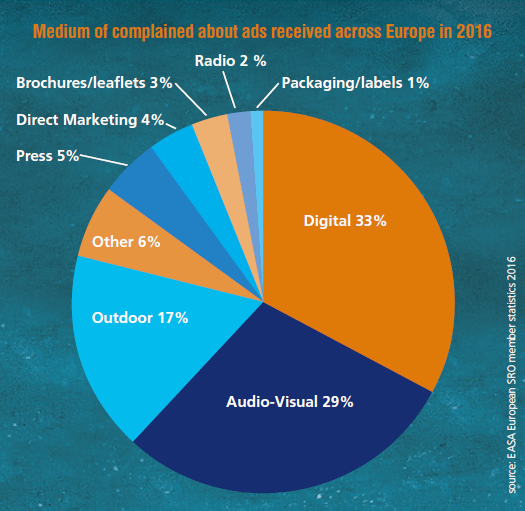
photos: Pernot Ricard Deutschland (1); Van Bavel Enjoy Giving (1); illustration: Jens C. Friedrich, © WA Media; Shutterstock.com


